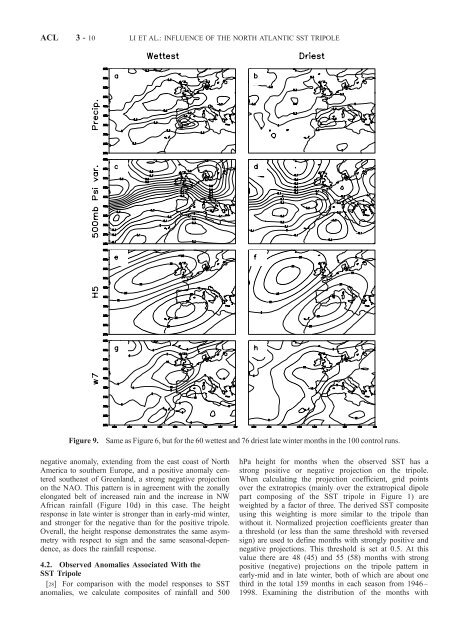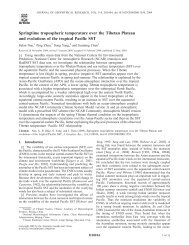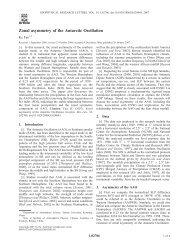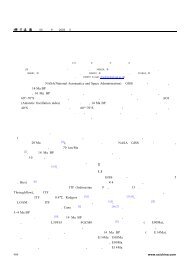Influence of the North Atlantic SST tripole on northwest African rainfall
Influence of the North Atlantic SST tripole on northwest African rainfall
Influence of the North Atlantic SST tripole on northwest African rainfall
Create successful ePaper yourself
Turn your PDF publications into a flip-book with our unique Google optimized e-Paper software.
ACL 3 - 10 LI ET AL.: INFLUENCE OF THE NORTH ATLANTIC <str<strong>on</strong>g>SST</str<strong>on</strong>g> TRIPOLE<br />
Figure 9.<br />
Same as Figure 6, but for <str<strong>on</strong>g>the</str<strong>on</strong>g> 60 wettest and 76 driest late winter m<strong>on</strong>ths in <str<strong>on</strong>g>the</str<strong>on</strong>g> 100 c<strong>on</strong>trol runs.<br />
negative anomaly, extending from <str<strong>on</strong>g>the</str<strong>on</strong>g> east coast <str<strong>on</strong>g>of</str<strong>on</strong>g> <str<strong>on</strong>g>North</str<strong>on</strong>g><br />
America to sou<str<strong>on</strong>g>the</str<strong>on</strong>g>rn Europe, and a positive anomaly centered<br />
sou<str<strong>on</strong>g>the</str<strong>on</strong>g>ast <str<strong>on</strong>g>of</str<strong>on</strong>g> Greenland, a str<strong>on</strong>g negative projecti<strong>on</strong><br />
<strong>on</strong> <str<strong>on</strong>g>the</str<strong>on</strong>g> NAO. This pattern is in agreement with <str<strong>on</strong>g>the</str<strong>on</strong>g> z<strong>on</strong>ally<br />
el<strong>on</strong>gated belt <str<strong>on</strong>g>of</str<strong>on</strong>g> increased rain and <str<strong>on</strong>g>the</str<strong>on</strong>g> increase in NW<br />
<strong>African</strong> <strong>rainfall</strong> (Figure 10d) in this case. The height<br />
resp<strong>on</strong>se in late winter is str<strong>on</strong>ger than in early-mid winter,<br />
and str<strong>on</strong>ger for <str<strong>on</strong>g>the</str<strong>on</strong>g> negative than for <str<strong>on</strong>g>the</str<strong>on</strong>g> positive <str<strong>on</strong>g>tripole</str<strong>on</strong>g>.<br />
Overall, <str<strong>on</strong>g>the</str<strong>on</strong>g> height resp<strong>on</strong>se dem<strong>on</strong>strates <str<strong>on</strong>g>the</str<strong>on</strong>g> same asymmetry<br />
with respect to sign and <str<strong>on</strong>g>the</str<strong>on</strong>g> same seas<strong>on</strong>al-dependence,<br />
as does <str<strong>on</strong>g>the</str<strong>on</strong>g> <strong>rainfall</strong> resp<strong>on</strong>se.<br />
4.2. Observed Anomalies Associated With <str<strong>on</strong>g>the</str<strong>on</strong>g><br />
<str<strong>on</strong>g>SST</str<strong>on</strong>g> Tripole<br />
[28] For comparis<strong>on</strong> with <str<strong>on</strong>g>the</str<strong>on</strong>g> model resp<strong>on</strong>ses to <str<strong>on</strong>g>SST</str<strong>on</strong>g><br />
anomalies, we calculate composites <str<strong>on</strong>g>of</str<strong>on</strong>g> <strong>rainfall</strong> and 500<br />
hPa height for m<strong>on</strong>ths when <str<strong>on</strong>g>the</str<strong>on</strong>g> observed <str<strong>on</strong>g>SST</str<strong>on</strong>g> has a<br />
str<strong>on</strong>g positive or negative projecti<strong>on</strong> <strong>on</strong> <str<strong>on</strong>g>the</str<strong>on</strong>g> <str<strong>on</strong>g>tripole</str<strong>on</strong>g>.<br />
When calculating <str<strong>on</strong>g>the</str<strong>on</strong>g> projecti<strong>on</strong> coefficient, grid points<br />
over <str<strong>on</strong>g>the</str<strong>on</strong>g> extratropics (mainly over <str<strong>on</strong>g>the</str<strong>on</strong>g> extratropical dipole<br />
part composing <str<strong>on</strong>g>of</str<strong>on</strong>g> <str<strong>on</strong>g>the</str<strong>on</strong>g> <str<strong>on</strong>g>SST</str<strong>on</strong>g> <str<strong>on</strong>g>tripole</str<strong>on</strong>g> in Figure 1) are<br />
weighted by a factor <str<strong>on</strong>g>of</str<strong>on</strong>g> three. The derived <str<strong>on</strong>g>SST</str<strong>on</strong>g> composite<br />
using this weighting is more similar to <str<strong>on</strong>g>the</str<strong>on</strong>g> <str<strong>on</strong>g>tripole</str<strong>on</strong>g> than<br />
without it. Normalized projecti<strong>on</strong> coefficients greater than<br />
a threshold (or less than <str<strong>on</strong>g>the</str<strong>on</strong>g> same threshold with reversed<br />
sign) are used to define m<strong>on</strong>ths with str<strong>on</strong>gly positive and<br />
negative projecti<strong>on</strong>s. This threshold is set at 0.5. At this<br />
value <str<strong>on</strong>g>the</str<strong>on</strong>g>re are 48 (45) and 55 (58) m<strong>on</strong>ths with str<strong>on</strong>g<br />
positive (negative) projecti<strong>on</strong>s <strong>on</strong> <str<strong>on</strong>g>the</str<strong>on</strong>g> <str<strong>on</strong>g>tripole</str<strong>on</strong>g> pattern in<br />
early-mid and in late winter, both <str<strong>on</strong>g>of</str<strong>on</strong>g> which are about <strong>on</strong>e<br />
third in <str<strong>on</strong>g>the</str<strong>on</strong>g> total 159 m<strong>on</strong>ths in each seas<strong>on</strong> from 1946–<br />
1998. Examining <str<strong>on</strong>g>the</str<strong>on</strong>g> distributi<strong>on</strong> <str<strong>on</strong>g>of</str<strong>on</strong>g> <str<strong>on</strong>g>the</str<strong>on</strong>g> m<strong>on</strong>ths with






